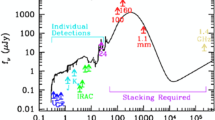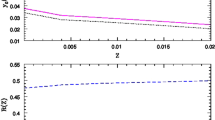Abstract
The inclusion of a detailed modeling of the short-scale baryonic physics in a large-scale cosmological simulation is crucial for a better comparison between observations and predictions from cosmological models. From a set of 3D hydrodynamical simulations which include a chemical model to account for the complex physics of the ISM at a sub-grid scale, we have been able to obtain a statistically significant sample of galaxy-type halos with observational properties, like colors and luminosities for different cosmological scenarios. From this data base, we have studied a number of different things, like Tully-Fisher relations, luminosity functions and environmental effects. Despite the progress made during the last few years in the modeling of the physics of ISM and star formation, more work is clearly needed.
Similar content being viewed by others
References
Ascasibar, Y., 1999, Ph.D. Thesis, in preparation
Eisenstein, D.J., Loeb, A., 1996, ApJ, 459, 432
Elizondo, D., 1996, PhD Thesis, Universidad Autónoma de Madrid
Elizondo, D., Yepes, G., Kates, R., Müller, V., Klypin, A., 1998a, ApJ, in press
Elizondo, D., Yepes, G., Kates, R., Klypin, A., 1998b, New Astronomy, (in press)
Giroux, M., Shapiro, I., 1986, ApJS, 102, 191
Kates, R., Müller, V., Gottlöber, S., Mücket, J.P., Retzlaff, J., 1995, MNRAS, 277, 1254
Kravtsov, A., Klypin, A., Khokhlov, A., 1997, ApJS, 111, 73
Khokhlov, A., 1998, J. Compt. Phys., 143, 519
Matteucci, F., 1997, ASP Conf. Ser., 126, 495
Petitjean, P., Mücket, J, Kates, R., 1995, A&A, 295, L9
Pierce, M.J., Tully, R.B., 1992, ApJ, 387, 47
Smith, M.S., Kawano, L.H., Malaney, R.A., 1993, ApJS, 85, 219
Yepes, G., 1997, ASP Conf. Ser., 126, 279
Yepes, G., Kates, R., Khokhlov, A., Klypin, A., 1997, MNRAS, 284, 235 (YK3)
Author information
Authors and Affiliations
Rights and permissions
About this article
Cite this article
Yepes, G., Elizondo, D. & Ascasibar, Y. Star Formation and Cosmological Simulations. Astrophysics and Space Science 263, 31–34 (1998). https://doi.org/10.1023/A:1002179611335
Issue Date:
DOI: https://doi.org/10.1023/A:1002179611335




